Two gems stand out among Sotheby’s Spring Sales series in Hong Kong. The first is a dazzling piece of imperial blue and white porcelain: an early 15th-century bowl made during the reign of Emperor Xuande exceptional for its design, quality of painting, and size. Four fat fish in a deep pond glide in and out of clumps of lotus and fronds of pondweed, ferns and fallen flowers, their gentle movements and the rippling of the water enhanced by the deep, barbed mallow shape of the bowl itself. The bravura painting exploits the full tonal range of the cobalt blue to bring depths and contrasts, the blue pigment both heaped and piled to achieve inky darks and incised down to the porcelain body to provide the white veining of the leaves. Naturalistic detail ranges from the sharp to the appropriately fuzzy. Of course, this being an imperial object, its subject is not so much swimming fish as their pleasing contemplative and philosophical associations.
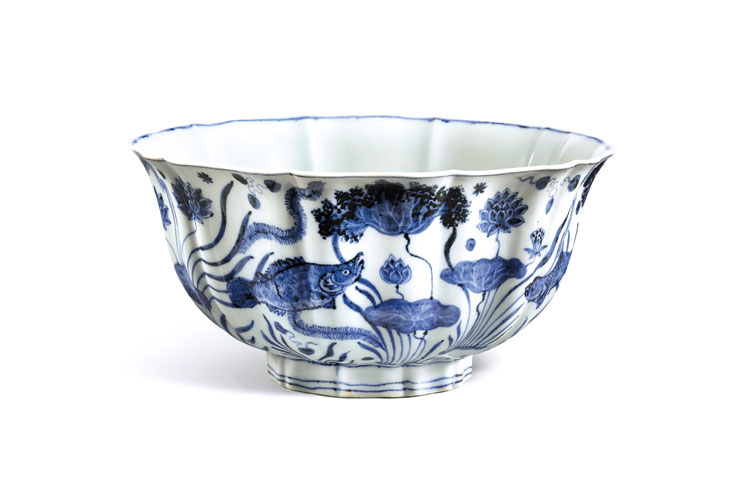
‘Fish Pond’ bowl, Ming, Xuande period (1426–35), blue and white porcelain, diam. 23cm. Sotheby’s Hong Kong, estimate in the region of HK$100m
Only two comparable but smaller pieces are known to exist, both in the National Palace Museum in Taipei. This bowl, widely published and exhibited in Japan since the 1960s but virtually unknown outside the country, has never been on the international market. Sotheby’s Nicolas Chow describes it as without doubt the best piece of Xuande porcelain he has ever handled, and it comes to auction on 5 April with an estimate of around HK$100m. On a good day, it may even break the record for a piece of early Ming porcelain.
The second tour de force is a thousand-year-old, over life-size fragmentary head of the bodhisattva Avalokiteshvara made in the complex – and of course, extremely fragile – ‘dry lacquer’ technique that allows for particularly refined modelling and detailing. Such massive sculptures began with a stick-like wooden armature over which the figure was shaped in clay. Hemp soaked in lacquer was then laid, and more layers of lacquer added which could be crisply carved and painted. When finished, the figures were cut open at the back and the wood and clay removed to leave a light, thin carapace. It is this combination of sensuous modelling and sharp, stylised line that imbues this head not only with its life, but also its aura of sanctity, wisdom and compassion. It may well date from the reign of the Tang emperor Xuanzong (reigned 712–756), which saw greater naturalism in sculpture and Buddhist deities rendered more approachable than before. Such survivors are exceedingly rare. It is expected to fetch upwards of HK$18m on 4 April.
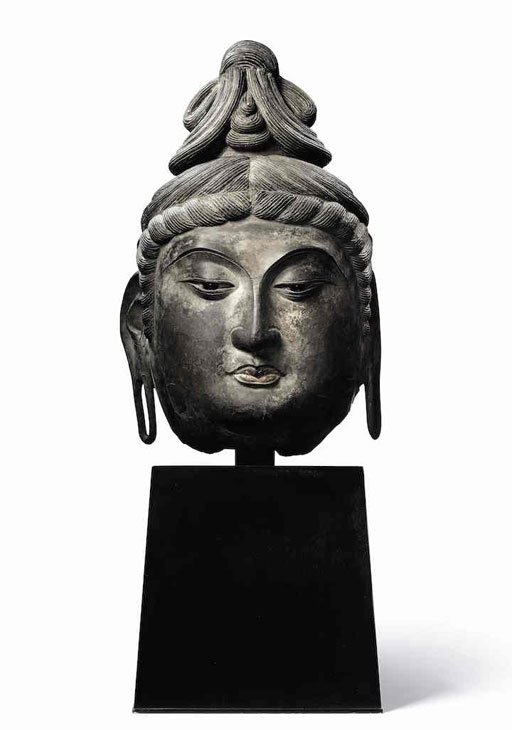
Head of Avalokiteshvara, Tang dynasty (618–906),
dry lacquer, ht 67.8cm. Sotheby’s Hong Kong, estimate: HK$18m–HK$25m
Christie’s Classic Art Week in New York offers the last of the Old Masters amassed by Chauncey Devereux Stillman (1907–89) – a collection best known for Pontormo’s celebrated Portrait of a Halberdier, long on loan to the Frick Collection in New York but now in the Getty. Presiding here is a very, very dirty, but rather magical early fête galante by Nicolas Lancret. Autumn is one of a series of four large-scale seasons commissioned around 1720 by Jean-François Leriget de La Faye, a poet and avid patron of art as well as a courtier and diplomat for Louis XIV. The success of the series, which was soon engraved, proved to be the turning point in the career of a young artist eager to break out of the shadow of the great Watteau.
It is a typical scene of festivities and flirtation in elegant parkland. This is the season of harvest and the amorous couples – including the commedia dell’arte figures of Harlequin and Pierrot – are evidently making the most of the fruits of the vine. There are passages of great delicacy and some unexpectedly bravura painting. Spring and Summer were subsequently acquired by Catherine the Great and are in the Hermitage; Winter has recently emerged in a private collection in France. Autumn came to Stillman with a Rothschild provenance. The current auction record for Lancret is just shy of $1m – but the market has not seen a work by him of this quality for a very long time. It is offered on 27 April with an estimate of $2m–$4m.
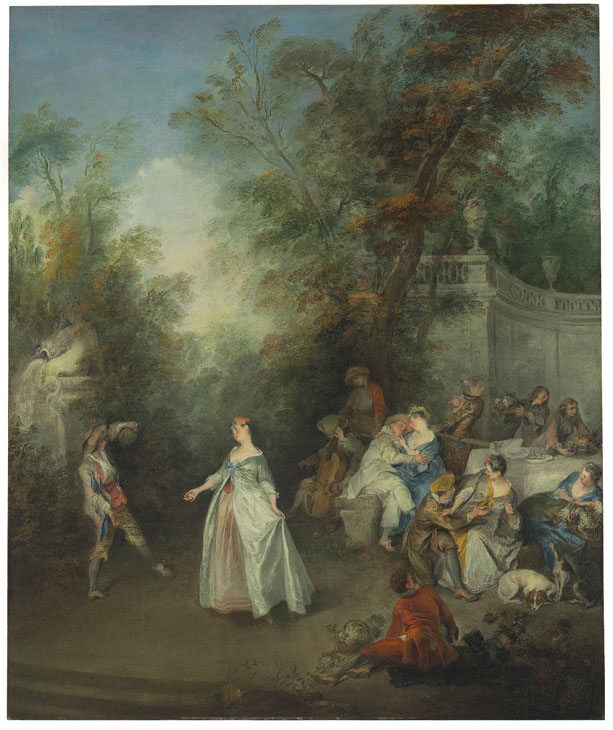
Autumn (commissioned around 1720) Nicolas Lancret. Christie’s New York, estimate: $2m–$4m
Another tour de force makes its way, rather surprisingly, to Christie’s New York’s The Exceptional Sale on 28 April. One of the most celebrated examples of English Georgian furniture is being deaccessioned by the Metropolitan Museum of Art – two years after the institution, which is renovating its English decorative arts galleries, offloaded other furniture and porcelain. It is an odd decision given the historical pre-eminence of this unique piece. In the 1920s it was published by Percy Macquoid and Ralph Edwards, and at great length by R.W Symonds. Symonds was an advisor to Percival Griffiths whose collection of English furniture is still regarded as the finest ever assembled, and this jewel of a George II walnut bureau-cabinet was its star.
Such a combination of tallboy and bureau was primarily intended for use in a bedroom. This example is striking for its delicacy – elegant, narrow proportions – and admirable carving, some of it gilt. Dated to around 1730, it is fascinating as a transitional piece: Palladian ornamentation has almost been grafted on to a Queen Anne case. Griffiths was a stickler for original detail, and here the patina, gilding, mirror plate and the brassware are all effectively untouched. Later – again on the advice of Symonds – the cabinet was acquired by the great American collector and Met benefactor, Judge Irwin Untermyer. Such was the admiration of the piece that Christie’s Melissa Gagen has seen numerous 20th-century American replicas over the years. Estimate $300,000–$500,000.
Textiles, so highly admired and expensive around the turn of the 20th century, must now rank among the most unfashionable and neglected of all applied arts. There are, of course, some conservation issues concerning their display and storage but how could anyone confronted with, say, the spectacular Ottoman silk velvet panels at the Gulbenkian Museum in Lisbon or the David Collection in Copenhagen deny that these are not only great works of art but great wallcoverings too?
On 26 April, a group of some 17 Ottoman textiles of the 16th and 17th centuries takes a bow in Sotheby’s London’s Arts of the Islamic World sale. These had belonged to Argine Benaki Salvago, described by Philip Mansel as ‘one of the “uncrowned queens of Alexandria”’, famous for her taste and her lovers of both sexes, seduced by her purple-blue eyes’. As so many of the Ottoman textiles on the market today are fragmentary, the star of this offering – an embroidered velvet panel – would be striking enough for its scale alone (162cm by 120cm) but it also rejoices in a vivid deep crimson ground and a highly abstract cintamani decoration, here arranged between tiger stripes. Such polychromatic decoration, often designed in the court ateliers in Constantinople for the weavers in Bursa, were created by alternating two or more warps in contrasting colours, brocaded with metal-wrapped threads. Estimated at £200,000–£300,00, it could easily fetch double.
From the April issue of Apollo. Preview and subscribe here.
Unlimited access from just $16 every 3 months
Subscribe to get unlimited and exclusive access to the top art stories, interviews and exhibition reviews.

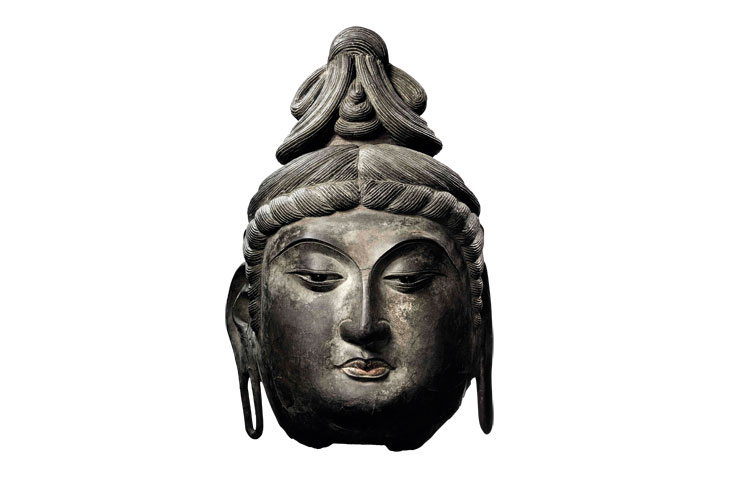

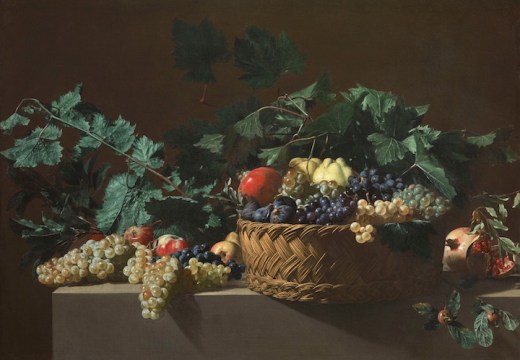
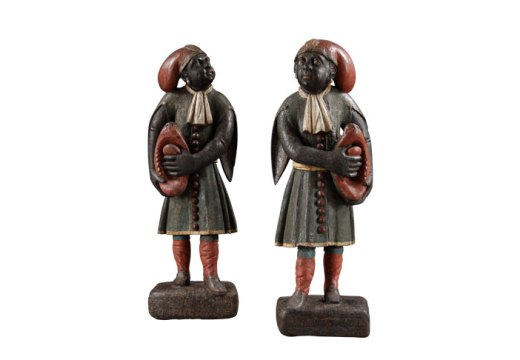









![Masterpiece [Re]discovery 2022. Photo: Ben Fisher Photography, courtesy of Masterpiece London](http://www.apollo-magazine.com/wp-content/uploads/2022/07/MPL2022_4263.jpg)
It’s time for the government of London to return to its rightful home